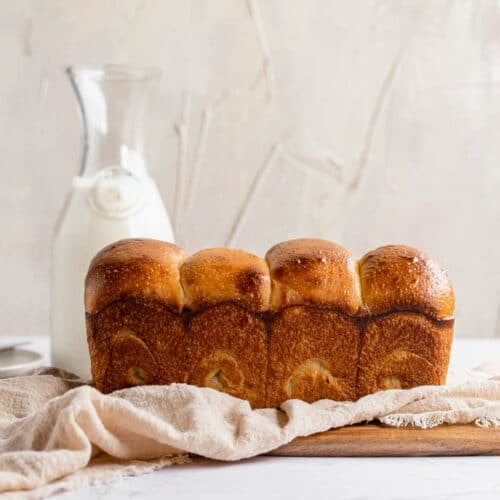
Sourdough Japanese milk bread
This fluffy sourdough milk bread is made using the tangzhong method to create the softest white bread loaf. A long, slow rise creates a rich, buttery flavor, and a no-knead method is perfect for making this bread completely by hand!
Equipment
- Mixing bowl
- Skillet
- Rolling Pin
- 9 x 5 inch loaf tin
Ingredients
Levain
- 30 g fed and active sourdough starter, 100% hydration
- 60 g milk, warm
- 60 g bread flour
Tangzhong
- 23 g bread flour
- 60 g water
- 60 g milk
Dough
- 275 g bread flour
- 50 g granulated sugar
- 4 g salt
- 60 g milk, warm
- 1 egg
- 60 g butter, room temperature
Egg wash
- 1 egg
- 1 tbsp milk
Instructions
Make the levain
- Mix together the sourdough starter, warm milk, and bread flour to create the levain. Cover and let rise until doubled in size. This takes about 4 - 8 hours.
Make the tangzhong
- In small skillet or pot, whisk together flour, milk, and water until smooth. Bring to simmer over medium-low heat, whisking frequently, until mixture has thickened but is still pourable. It should take 5 – 10 minutes. Your whisk should leave a mark when dragged along the bottom of the pan.
- Pour into a bowl and cover surface with plastic wrap to prevent a film from forming, and allow to cool to room temperature.
Make the dough
- In a mixing bowl, add the flour, sugar, salt, milk, egg, levain, and tangzhong. Mix until a shaggy dough forms. Use your hands to gently mix in the softened butter.
- Cover the bowl with plastic wrap and let sit for 30 - 45 minutes.
- Gently slide your hand under the middle of the dough and fold it over itself twice using the coil fold method. This helps gently develop the gluten.
- Over the next 2 to 3 hours, allow the dough to rise, performing a coil fold every 30 – 45 minutes.
- Cover the dough with plastic wrap and place in the fridge for at least 8 hours and up to 24 hours.
- Grease a baking tin. Remove the dough from the fridge and turn out onto a lightly floured surface. Divide into 4 equal pieces. For perfectly even pieces, you can weigh them - they should be about 200g each. Gently shape each piece into a ball.
- Use a lightly floured rolling pin to roll one of the balls into a rectangle about 4 inches wide and 8 inches long. If the dough is shrinking, let it sit for 10 minutes to help the gluten relax. With the short end of the rectangle facing you, roll the dough away from you to form a 4 inch wide coil. Place into the greased baking tin. Repeat with the remaining 3 balls of dough and place them side by side in the tin.
- Cover the tin and let proof until the dome of the dough rises above the edge of the pan. This takes 6 - 10 hours depending on how warm your kitchen is. I like to place my dough in the oven with the oven light on and door cracked to help create a warmer environment.
- When you're ready to bake, preheat the oven to 400°F. Whisk together the egg and milk to create the egg wash and brush over the top of the loaf. Pop any obvious air bubbles.
- Place in the middle rack and bake for 10 minutes. Then, reduce the temperature to 350°F and bake for another 20 minutes until the loaf is evenly golden brown on top and makes a hollow sound when tapped.
- Remove from the oven and let cool in the pan for 15 minutes. Remove from the pan and let cool for another 30 minutes - 1 hour on a wire cooling rack.
Notes
- Make sure that the milk is warm, but not hot. If it's too hot, it will kill the yeast. I usually microwave for ~10 seconds until warm to the touch.
- If you want to bake the bread at a different time, you can place the loaf in the fridge after the second proof until ready to bake.